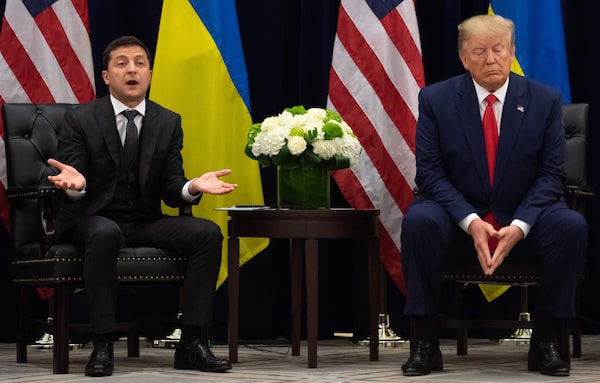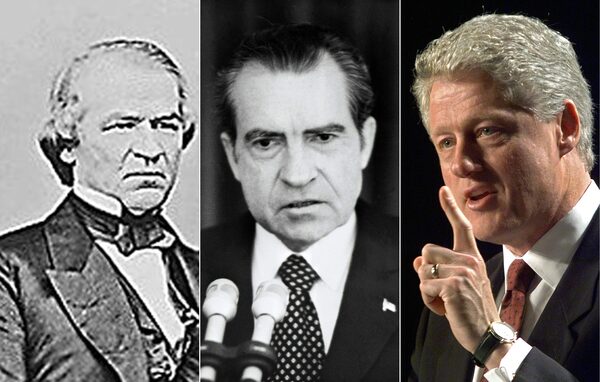Washington, Jan. 15: U.S. House Speaker Nancy Pelosi is surrounded by the House impeachment managers and committee chairs as she signs the two articles of impeachment against U.S. President Donald Trump before sending them over to the Senate.Leah Millis/Reuters/Reuters
The latest
- U.S. President Donald Trump’s trial is headed for the Senate at last after House members delivered articles of impeachment in a Wednesday ceremony. The procession took place four weeks after the Democratic-led House voted to impeach the Republican president, but House Speaker Nancy Pelosi stalled for time, hoping to get more concessions from her Senate counterpart that the trial would be conducted fairly in the Republican-held Senate.
- Ms. Pelosi named seven House “managers” on Wednesday who will make the case to senators that Mr. Trump abused the power of his office and obstructed Congress. The team is led by Adam Schiff and Jerrold Nadler, chairmen of the House intelligence and judiciary committees, respectively, who lead the investigation and hearings.
- Senate Majority Leader Mitch McConnell has declared witnesses unnecessary and has pushed off the matter until after evidence is presented. He is hoping to head off Democrats seeking potentially damaging testimony witnesses like former national security adviser John Bolton, while also keeping any courtroom drama to a minimum.
The articles of impeachment explained
Lawmakers in the Democrat-controlled House of Representatives voted on Dec. 18 on two articles of impeachment, or specific accusations of wrongdoing, against U.S. President Donald Trump. (The wording for both articles is in the document below.) One article has to do with whether Mr. Trump abused the powers of his office; this one passed 230-197. The other is about whether he obstructed Congress by preventing people in his administration from testifying, even when they were issued subpoenas; this one passed 229-198. On each question, the issue was whether Mr. Trump’s behaviour amounts to “treason, bribery, or other high crimes and misdemeanours,” the Constitution’s benchmark for impeachment.
House Republicans were united in their opposition to both impeachment articles. Two Democrats, Collin Peterson and Jeff Van Drew, voted no on both; another, Jared Golden, voted against the obstruction article, but for abuse of power. Tulsi Gabbard, a House Democrat who is seeking her party’s presidential nomination, voted “present” on both articles, declaring in a statement: “I could not in good conscience vote either yes or no.”
Nearly a month passed after the vote, during which time House Speaker Nancy Pelosi tried to press her Republican counterpart, Mitch McConnell, to agree to rules that would guarantee Mr. Trump a fair trial in the Senate. She delayed giving the Senate the articles of impeachment until January, when the House finally voted to transmit the articles on Jan. 15.
What are these impeachment proceedings about?

New York, Sept. 25, 2019: U.S. President Donald Trump listens as Ukrainian President Volodymyr Zelensky speaks to the press on the sidelines of the United Nations General Assembly.SAUL LOEB/AFP via Getty Images
The core issue for Congress is whether Mr.Trump abused his power for personal gain in his dealings with his Ukrainian counterpart, Volodymyr Zelensky. This past July, when Mr. Trump called Mr. Zelensky on his election, he also asked if he would “do us a favour” by investigating Burisma, a Ukrainian company linked to the son of Joe Biden, the front-runner for the Democratic presidential nomination. At the same time, Mr. Trump was holding back nearly US$400-million in military aid to Ukraine, which raises questions about whether he was creating leverage to have Ukraine dig up dirt on Burisma that could be used to discredit Mr. Biden. If so, that’s not just a diplomatic faux pas: It’s against federal law to solicit anything of value from a person from a foreign country in U.S. elections.
An intelligence official filed a complaint about Mr. Trump’s request and the administration’s subsequent efforts to hide records of the conversation in a special national-security database. You can read the full complaint in the document viewer below. News of the whistleblower’s complaint broke in September, and momentum quickly grew in the Democrat-controlled House of Representatives to start a formal impeachment process, which it did on Sept. 24. House committees began calling diplomats, intelligence officials and White House aides to testify, and a second whistleblower came forward to corroborate and expand upon the first one’s findings.

Some of the key figures in the impeachment proceedings so far. Top row: Alexander Vindman, National Security Council director for European Affairs; Jennifer Williams, aide to U.S. Vice-President Mike Pence; Kurt Volker, U.S. ambassador to NATO and U.S. special envoy for Ukraine. Middle row: Gordon Sondland, U.S. Ambassador to the European Union; David Holmes, a State Department official; Tim Morrison, top Russia and Europe adviser on the National Security Council Tim Morrison. Bottom row: Fiona Hill, former deputy assistant to the President; David Hale, U.S. under-secretary of state for political affairs David Hale; and Laura Cooper, deputy assistant secretary of Defense for Russia, Ukraine, and Eurasia.MANDEL NGAN/AFP/Getty Images
What Congress learned
Since this fall, the impeachment process has had three broad phases, all in the House of Representatives: Fact-finding hearings in September and October, where witnesses testified behind closed doors; public hearings of the intelligence committee in November, which brought back many of the same witnesses; and public hearings of the judiciary committee, where experts were consulted about their views of whether the President’s conduct was impeachable. Here’s what some of the key witnesses said:
- Mr. Trump made the release of U.S. security aid to Ukraine contingent on Kyiv publicly declaring it would carry out the investigations that the U.S. president sought, William Taylor, the top U.S. diplomat in Ukraine, testified. Mr. Taylor also said Mr. Trump had also made a White House visit by Mr. Zelensky contingent on his opening the investigations.
- Gordon Sondland, U.S. ambassador to the European Union, originally told committee members he couldn’t recall conversations about a quid pro quo with Ukraine, but later reversed himself in a letter acknowledging he had told a Ukrainian official that the aid would be withheld until Kyiv agreed to an investigation.
- Tim Morrison, the National Security Council’s top adviser for Russian and European affairs until he stepped down on Oct. 30, confirmed that the U.S. military aid was being withheld from Ukraine because of a quid pro quo, but said he didn’t know that until a Sept. 1 conversation with Mr. Sondland. He also said "I was not concerned that anything illegal was discussed” in the July phone call, and that in his view, the quid pro quo at the centre of the impeachment inquiry was not illegal.
- Text messages between Mr. Sondland, Mr. Trump’s Ukraine special envoy, Kurt Volker, and Mr. Trump’s personal attorney, Rudy Giuliani, show that pressure was exerted on Mr. Zelensky to make a public statement committing himself to investigating Burisma before he would be allowed to meet with Mr. Trump at the White House. Earlier, Mr. Volker testified that he had helped to connect Mr. Giuliani with a top aide to Mr. Zelensky. Mr. Volker said he was unaware at the time of Mr. Giuliani’s mission to dig up dirt on the Bidens, and that in text messages between him, Mr. Sondland and Mr. Giuliani, there was no explicit mention of the Bidens.
- The former U.S. ambassador to Ukraine, Marie Yovanovitch, testified that Mr. Trump ousted her from her position based on “unfounded and false claims” after she had come under attack by Mr. Giuliani. She was abruptly recalled from Kyiv in May. She expressed alarm over damage to diplomacy under Mr. Trump and warned about “private interests” circumventing “professional diplomats for their own gain, not the public good.”
Hearing highlights: Read The Globe’s reports
Nov. 19: Volker says he should have recognized push for Ukraine probe was tied to Biden
Dec. 4: Three experts tell House committee that Trump committed multiple impeachable offences
What happens next

Andrew Johnson, Richard Nixon and Bill Clinton are the only three presidents other than Mr. Trump to have faced impeachment proceedings. None were removed from office.Paul J. Richards/AFP/Getty Images
Now that articles of impeachment have passed in the House, the president is considered “impeached,” or formally accused. That’s only happened twice before, to presidents Andrew Johnson and Bill Clinton. (Richard Nixon was about to face impeachment in 1974, but he quit before the House could vote on the articles they had prepared.)
Next, the Senate holds what is essentially a trial where the president and his lawyers can defend their case. The Chief Justice of the Supreme Court presides over this trial, and seven House-appointed “managers” (including the chairmen of the House judiciary and intelligence committees) will make their case to senators that Mr. Trump’s conduct merits his removal. Republicans hold the majority in the Senate and would be more likely to side with Mr. Trump. At the trial’s end, senators vote on the articles of impeachment one at a time, and if one is approved by a two-thirds-majority vote, the president is removed from office.
Commentary and analysis
Andrew Cohen: Trump's impeachment is the latest act in the melodrama that is America
Lawrence Martin: How Donald Trump will escape impeachment’s clutches
Clifford Orwin: For the sake of the party, Republican senators must start the revolt against Trump
Yuri Polakiwsky: How Ukraine can avoid the swamp of Donald Trump’s impeachment hearings
Associated Press and Reuters, with reports from Adrian Morrow
Compiled by Globe staff
Our Morning Update and Evening Update newsletters are written by Globe editors, giving you a concise summary of the day’s most important headlines. Sign up today.